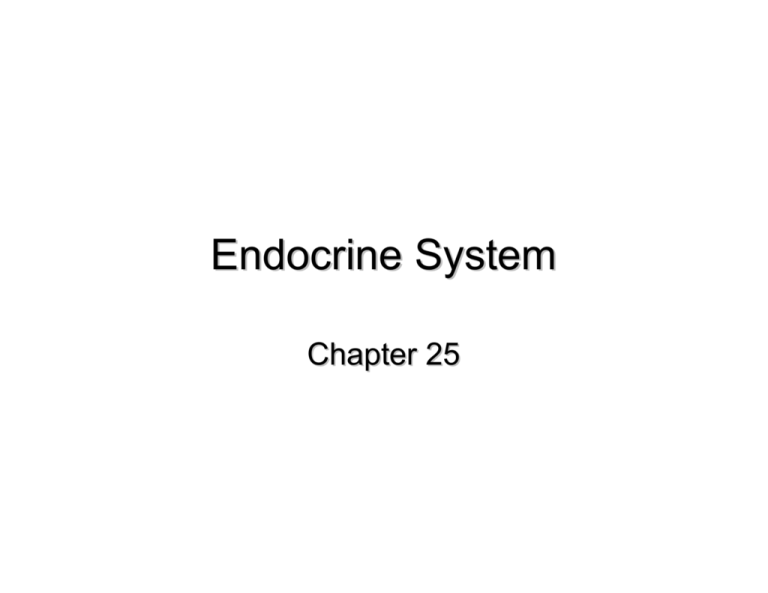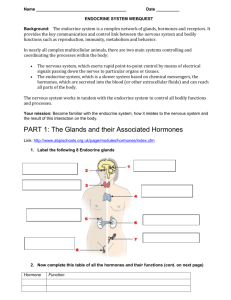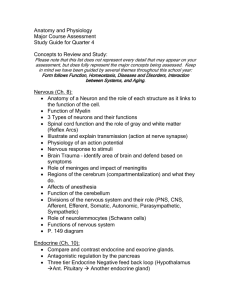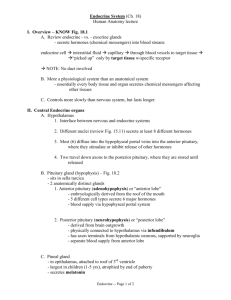Endocrine System
advertisement

Endocrine System Chapter 25 Endocrine System • Communication • Integrates body functions in conjunction w/ nervous system • Ductless glands that secrete hormones directly into the extracellular space where hormones diffuse into blood stream • Some specific functions are: – – – – Growth of body and reproductive structures Mobilize body fat Maintain proper blood chemistry Maintenance of metabolic rate Comparison of Nervous System and Endocrine System Regulation of Homeostasis Characteristic Nervous System Endocrine Systems Mechanism of Control Neurotransmitters released in response to nerve impulse. Hormones delivered throughout the body through the blood stream. Cells Effected Muscle cells, gland cells, other neurons. Virtually all body cells. Type of Action Muscular contraction or glandular secretion. Changes in metabolic activities and growth patterns. Time to onset of action Within milliseconds. Seconds to hours. Duration Briefer Longer Hormone Secretion Stimulation and Inhibition: • Signals from the nervous system – e.g. adrenal medulla release of epinephrine Hormone Secretion Stimulation and Inhibition: • Chemical changes in the blood – e.g. blood calcium level regulates parathyroid hormone Hormone Secretion Stimulation and Inhibition: • Other hormones Feedback Systems • A product of the target organ causes the hormone producing gland to produce less hormone. Endocrine vs. Exocrine • Recall, endocrine glands are ductless and release hormones which diffuse into blood stream. – e.g. pituitary, thyroid, etc. • Exocrine glands are ducted and secrete products into body cavities or surfaces. – e.g. sweat glands, mammary glands, mucous glands, liver (bile), pancreas (digestive enzymes) Hypothalamus • Influences the pituitary by – Direct nervous stimulus – Hormonal influence • Considered a neuroendocrine gland • Pain, stress, emotions effect responses Hypothalamus → pituitary → other endocrine glands Pituitary • Descends from hypothalamus and secretes 9 hormones • Gland considered to be part of the nervous and endocrine system. Pituitary + Hypothalamus • Important roles in regulation of: – Growth – Development – Metabolism – Homeostasis Hypothalamus → pituitary → (thyroid, adrenal cortex, gonads) Pineal (epithalamus) • Secretion of melatonin which is important for biological rhythms. • Sunlight received through retina ultimately inhibits secretion of melatonin. • Darkness stimulates melatonin….sleepy. Thyroid • Mainly controlled by pituitary (TSH) to regulate basal metabolic rates. Parathyroid • Located on posterior surface of the thyroid. • Regulates blood calcium and phosphate levels through (PTH). Thymus • Located in the mediastinum behind sternum and between lungs. • Lymphocytes differentiate into T-cells under influence of thymus…. immunological responses. • Thymus atrophies with age. Adrenals • Each gland is located on the superior and medial aspects of each kidney. • Adrenals made up of two encapsulated glands. Adrenals • Outer adrenal cortex – Cortex is involved in metabolic reactions and secretes steroid hormones (corticosteroids) necessary for life. Control fluid and electrolyte balance. • Inner adrenal medulla – Secretes epinephrine (adrenaline) and norepinephrine (noradrenaline) to elicit “fight or flight” reaction. These are protein hormones. – Under ANS control Pancreas • Located poster to the stomach and attached to small intestine. • Both an endocrine (1%) and exocrine (99%) organ. • Endocrine portion produces 4 peptide hormones, 2 of which help in controlling blood sugar. – Insulin & glucagon The Gonads • Ovary – Promotes the development and maintenance of female sex characteristics, reproductive structures, etc. – Regulates female menstrual cycle, maintains pregnancy, and readys mammary glands for lactation. The Gonads • Testes – Produce gonadal homrone testosterone. – Stimulates descent of tests during male development – Regulates spermatogenesis – Promotes development and maintenance of male sexual characteristics • Facial hair, muscular build, size of larynx, and sex drive.











